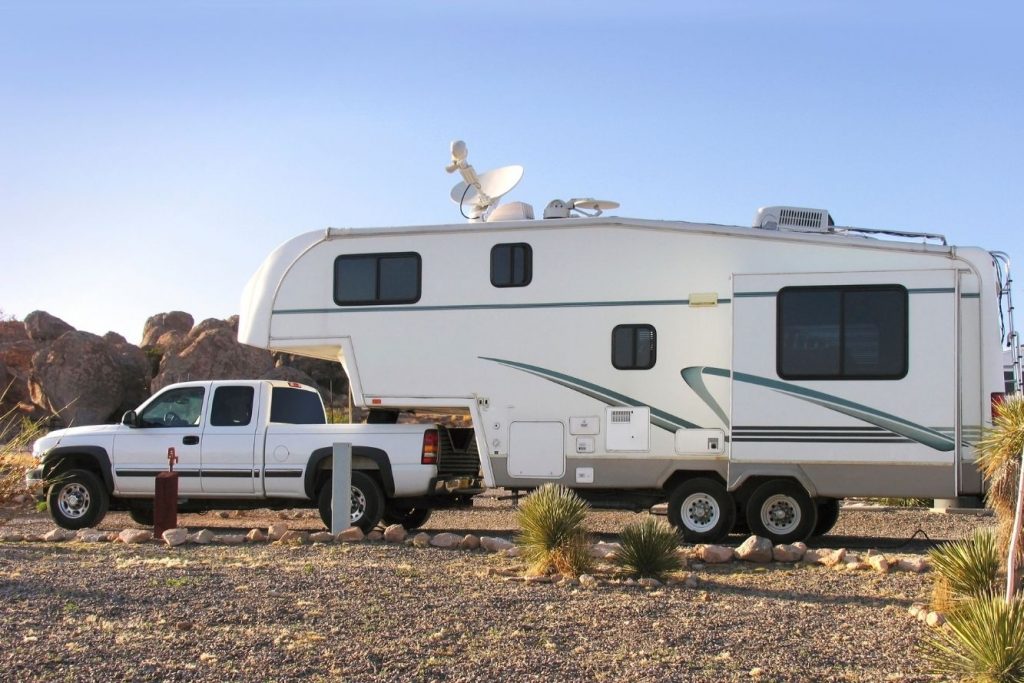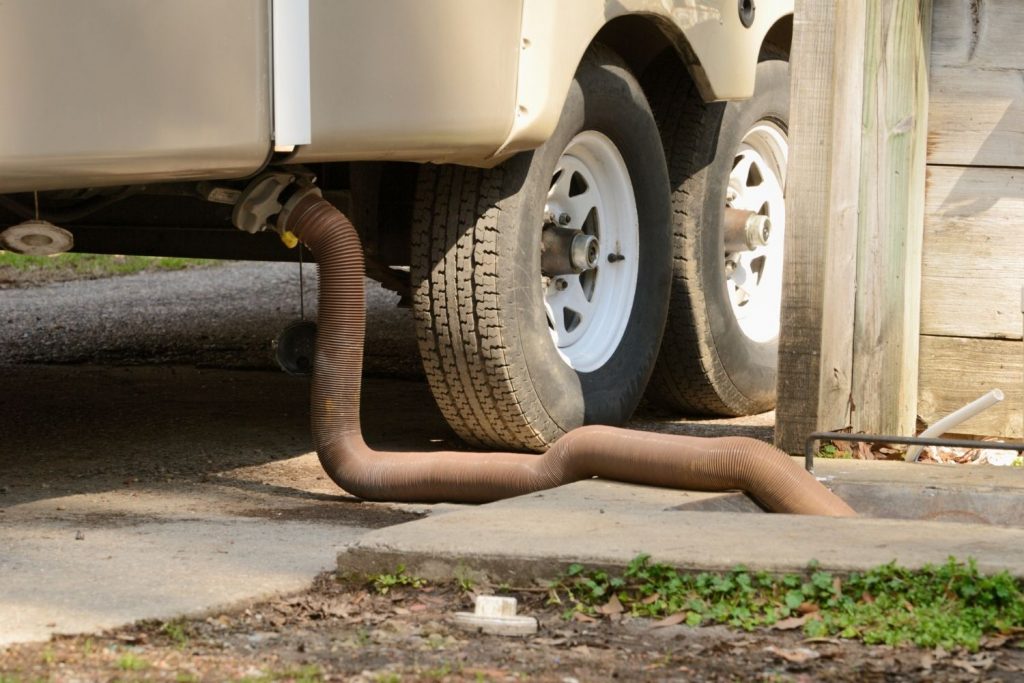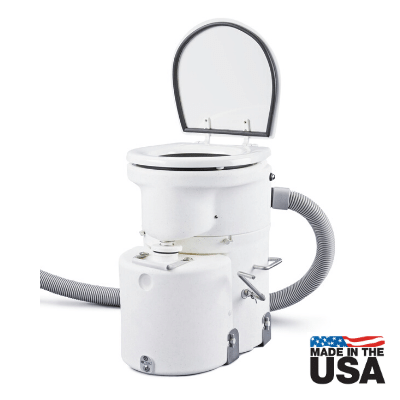Controversial opinion: I think the Airhead Composting toilet is slept-on in the RV and vanlife communities. And what I mean by that is that it’s so underrated and doesn’t get the press that it deserves!
If you’ve been in the RV or vanlife online communities for any amount of time, you’ve probably heard a lot about the Nature’s Head composting toilet. I’ve had two, and they’re terrible!
The Air Head composting toilet is the best on the market today for many reasons, and we’re about to get into it. Short on time? Use the table of contents to jump to different sections!
What is the Airhead Composting Toilet?
The Airhead Composting toilet is a separating composting toilet that can be used in many applications. This composting toilet is favored by many people living a tiny and nomadic lifestyle, and it’s not hard to see why!
The Air Head Composting Toilet outshines its competition in many ways. Let’s take a closer look at how this composting toilet works.
Related Reading: 7 Best Composting Toilet for RV and Van Life (Plus What You Need to Know)
How Does the Airhead Composting Toilet Work?
The Airhead is a separating, or urine-diverting, composting toilet. This means that the toilet separates solids and liquids into two different holding containers.
The act of separating the solids and liquids creates an odorless composting toilet that’s easy to use, easy to clean, and easy to maintain.
The rear bin of the Air Head Composting Toilet holds a composting medium, typically peat moss or coconut coir (shredded coconut husks). This is where the solids (or the #2’s) goes.
On the front of the toilet, there is a two-gallon jug that holds liquids, or #1’s.
The bowl of the toilet looks and feels much like a residential toilet, with a few major differences.
The bowl of the Air Head composting toilet is slanted towards the front with openings for liquids to flow into the liquids jug.
In the center of the bowl is a flap that opens via a handle for the solids to drop into the solids bin.
The solids bin, where the composting happens, has a crank attached to a handle on the outside of the toilet. It also has a small, low-powered electrical fan to blow over the medium to help dry it out.
Whenever you use the solids bin, you crank the handle a few times and you’re done! There is no water or flushing involved with this toilet – hence why it’s called an “Air” head.
Features and Specs of the Air Head Toilet
The design of this toilet is really where it shines compared to it’s competition. This toilet has a residential-style toilet seat and toilet seat lid. The two-gallon liquids jug is opaque except for a small window to see when it’s full.
Unlike competitors, you do not have to lift the top of the toilet to remove the liquid jug.
This toilet comes with the liquid jug, the toilet itself, the crank assembly, the fan assembly, a hose for venting, mounting hardware, and bowl liners. The bowl liners are handy to keep your toilet bowl clean, since water isn’t involved.

Download this FREE ebook learn 60+ ways to earn an income from anywhere!
The Airhead Composting Toilet for RVs, Boats, Vans, Tiny Houses, and More
So, where can you use an Airhead composting toilet? Wherever you want!
The Airhead composting toilet is a popular choice for those on the road in RVs and vans. But these types of toilets are also great in marine applications like sailboats, and they’re popular among the tiny house crowd too!

Benefits of a Composting Toilet
I’m not afraid to say it: I love composting toilets. I actually know so much about composting toilets that my friends come to me with questions about them all the time.
I never in my wildest dreams imagined that in my 30’s I’d be the go-to toilet expert in my friend group… but here we are. Life is funny that way.
I’ve owned a few composting toilets over the years, so I’m really familiar with the benefits of using them. Here are the top reasons I think everyone in a tiny or nomadic life should make the switch:
No Sewage
You read that right. No. Sewage. With a composting toilet, specifically a separating composting toilet, you never have to deal with sewage. Sewage is created when #1's and #2's mix – and that will never happen with a composting toilet.
Within a few hours of solids – aka #2's – landing in the composting bin, most of the harmful bacteria has died off.
Human liquid and solid waste mixing together and creating sewage is a major biohazard. And if you’re in an RV, you get to deal with your sewage often via a black tank.
A black tank is where everything you flush down your toilet goes until you drive to a dump station, hook up a big hose, and dump it into the sewers.
Honestly, it’s disgusting. It smells terrible, it’s a crappy job (literally), and it’s not environmentally friendly.

No Odor
Since there is no sewage, there is no odor with a composting toilet. And I say this with a caveat: there is no sewage odor. There’s also no “poop” odor. And there is zero odor that will permeate into your RV, van, or other tiny living space.
The only time you’ll smell something is when you open your toilet to empty your solids bin. And, since that bin is filled with an earthen material like coconut husks or peat moss, it smells like moist earth. Not poop – earth.
Honestly, the liquids container can be the part of the toilet that smells the worst. Stale pee tends to develop a strong smell, but you won’t ever smell it unless you’re dumping the jug.
Easy to Use and Install
Composting toilets are easy to use and easy to install. Some composting toilets are easier to use than others.
Since the Airhead composting toilet has a residential style toilet seat, it’s really easy to use. It feels almost just like a residential toilet!
Installation of a composting toilet is incredibly simple. There is no hooking up to plumbing, no worrying about leaks, no fitting the toilet.
The only technical work that you need to do to install a composting toilet is to cut a hole for a vent hose and hook up the power – but the power is 12v, for the fan, and very simple to do!
No Plumbing Required
No water necessary for this toilet, and no plumbing required. This is a major benefit for people building out their own camper vans. It’s also a serious advantage for someone building a tiny house!
You don’t have to worry about sewage or digging out a whole septic system for your tiny house if you install a composting toilet.
Saves Water
This is a big bonus for RVers, especially those who like to boondock. A composting toilet doesn’t use any water at all.
So, if you’re boondocking, you not only save fresh water, but you don’t have to worry about a black tank filling up either.
Environmentally Friendly
Composting toilets are environmentally friendly. They don’t create raw sewage. Plus, they don’t use any harsh chemicals.
Whether using chemicals to clean a toilet or putting chemicals into an RV black tank to help with the odor, conventional toilets do a lot of damage to the environment.

What Do You Do With Waste from a Composting Toilet?
You can dump liquid waste – aka pee – from your composting toilet almost anywhere. If you’re boondocking, it’s okay to spread the liquids around mature vegetation as long as there aren’t laws or ordinances against it. Spread it out rather than dump it in one spot to minimize impacts.
Or, you can dump the liquids into a vault toilet or public restroom.
You can dump your solids from your composting toilet into a dumpster. To dump your solids bin, you empty it into a trash bag. That trash bag can be disposed of with regular household trash.
It might sound or seem crazy, but it doesn’t even look like there’s human waste in it. It just looks like moist dirt, and it doesn’t smell, either.
How Long Can You Use Airhead Composting Toilet Before Emptying It?
The liquids container of an Air Head toilet will need to be emptied every day or two, depending on use. Even if you aren’t using it very often, it’s a good idea to empty it every day to prevent odors and build-up in the container.
The solids bin only needs emptied every 2 weeks to a month or longer depending on frequency of use. If you have many people using one toilet, it may need emptied more often.
Can You Put Toilet Paper in an Airhead Toilet?
Yes, you can put toilet paper in an Airhead toilet. But you might not want to!
Toilet paper will cause the solids bin to fill up faster, which means you have to dump it more often.
Personally, I keep a trash can with a lid in the bathroom for toilet paper. It’s faster to take out the trash than it is to dump your toilet more often!

Why the Airhead is the Best Composting Toilet on the Market Today
The Airhead Composting Toilet is built better than it’s competitors. I’ve personally owned two Nature’s Head toilets and let me be the first to tell you: they’re not as great as the influencers tell you that they are.
I, too, was swayed by all the YouTube videos and blog articles promoting the Nature’s Head toilet.
Little did I know at the time that those people were earning money everytime someone bought a Nature’s Head! So of course they’ll tell you it’s the best composting toilet in the world. It’s not.
As of the time of this writing, Air Head does not offer an affiliate program. So I'm not being paid to write this!
It really makes you think, doesn't it? Personally, I do earn money from affiliate programs. But I'd never recommend something that totally sucks just to earn a commission.
The Airhead is built with users in mind. The manufacturers pay close attention to detail, so this toilet is much easier to use, easier to install, and easier to clean than other composting toilets. Since the Nature’s Head is the top competitor, let’s compare the two.
AirHead vs Nature’s Head Composting Toilet
The main difference between the Air Head and Nature's Head composting toilets is the quality of design and ease of use of the toilet. Spoiler alert: Air Head wins this comparison.
These two toilets are similar in price range, but they’re vastly different in quality. Let’s start with the Nature’s Head.
I've included a great (and quick) video walkthrough of a side-by-side comparison of the two toilets for visual learners at the end of this section.
Nature’s Head Toilet
The Nature’s Head toilet is simply molded plastic. The seat isn’t comfortable and the lid is not air-tight.
Inside the solids compartment of the Nature’s Head composting toilet are lots of nooks, crannies, and crevasses that could (and should) be filled before sale. These nooks and crannies are impossible to clean and can create a major problem if you ever visit an area where fungus gnats are present.
Dumping the Nature’s Head
When you need to dump the liquids – which is about every day – you have to lift the entire top off of the Nature’s Head toilet to access the jug. (You don’t have to with the Airhead). Also, the liquids jug is clear. Not that it really matters – but if you’re walking through a campground with a jug of yellow liquid, everyone knows you’re carrying your pee around.

Air Head Toilet
This toilet is just better all-around. From the design to the finishing touches, everything about the Air Head toilet is different and better.
Let’s start with the seat. This toilet comes with an actual toilet seat and lid. Even better? The toilet seat has a rubber seal, so this toilet is air-tight. Composting toilets don’t smell, but sometimes the liquids can develop an odor. That odor can leak out of the toilet if there isn’t an air-tight lid like on the Air Head.

Dumping the Air Head
Dumping the Air Head is easier and more pleasant for several reasons. First of all, the Air Head toilet has handles on the side. This makes it really easy to dump the solids into a garbage bag. The Nature’s Head doesn’t have handles – this makes it hard to grasp and harder to get a grip on to dump it.
In addtion, the shape and material of the solids bin is a lot easier to dump and clean. It's smooth and round, with no weird nooks and crannies.

The liquids jug on the Air Head secures with a couple clasps. You don’t have to lift the top off of the toilet to dump the liquids. You simply have to unclasp and pull it out!
Also, the jug is an opaque white with a small clear window to see when it’s full. This is a con for some people, but I would much rather carry a white jug of pee through a campground than a clear one.
How Much Does the Airhead Toilet Cost?
A complete kit for an Air Head composting toilet costs just over $1k. I know… that’s a LOT for a toilet. I get it.
But the Nature’s Head is over $900… so this is a pretty common price for composting toilets.
For just $100 more, you get a much higher quality toilet that is going to last a long, long time.
Am I Biased Towards an Air Head?
Yes. I am biased towards an Air Head. But that bias has valid roots: I used two different Nature’s Head toilets for 4 years in an RV and then in a camper van. I HATE them.
At first, I thought I just had a faulty toilet. I’d heard of that. A good friend of mine got a faulty Nature’s Head and had to send it back for a new one. Spoiler alert: she hates the new one too.
So, I thought surely a second, new Nature’s Head toilet would be a better experience. It wasn’t.
Almost every issue I had with the Nature’s Head toilet was solved by the Air Head. The dumping experience, the air-tight seal, the handles on the side, and the opaque liquids jug.
Bottom line: The Air Head Composting Toilet is the best on the market, hands down.

Carrie Wilder
Carrie has a passion for location independence and nomadic lifestyles. After traveling full-time in an RV and living the van life, she created Making Money and Traveling to help others make the switch to a remote lifestyle. Learn more about Carrie on the About page or connect on social media below.
Download this FREE ebook learn 60+ ways to earn an income from anywhere!